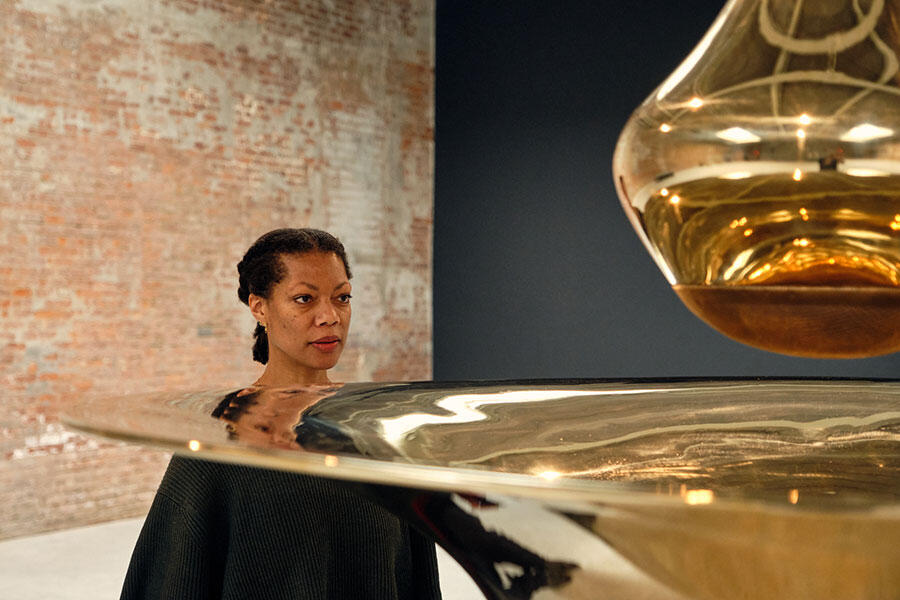Camille Norment’s Sonic Experience
Emma McCormick-Goodhart speaks to Camille Norment about her sound installation at Dia Chelsea and how we can better learn to read the room
Emma McCormick-Goodhart speaks to Camille Norment about her sound installation at Dia Chelsea and how we can better learn to read the room

Camille Norment’s ‘Plexus’, a live, site-responsive acoustic installation at Dia Chelsea, invites us to move ourselves, echolocatively, through two spaces of distinct vibrational sensibilities. A sounding brass form, viscous and svelte, plays anchor in the first, as if a hearing trumpet from the deep future worn by the room itself. Its effect is that of a conditioning chamber, tuning us to our own motion-generated sonic feedback, alongside the static, somehow lush, fragments of archival radio scrubbed of voice.
In dramaturgical leap in the second room, a strewn scaffold of wooden beams, whose hidden exciters play conduit to tone, makes available different kinds of vibrotactile listening practices, including to elasticated voices via bone conduction. To attend to these spaces means to observe how Norment’s forms, at once productive of sound and receptive to it, double as gathering technologies of bodies in varying states of prehension.

Emma McCormick-Goodhart: I’m interested in how you inhabit project sites from the outset, what your methods are, and the extent to which you feel that a space begins to speak to and through you, for instance in preparation for your current show, ‘Plexus’, at Dia Chelsea.
Camille Norment: It’s all too easy to develop methods that end up preventing you from seeing or hearing what’s actually there. When I first enter into a space, it is literally to listen and feel it – to experience my body in that specific locale, and to allow responses to emerge. Usually a conversation is started from the combination of architectural structure and its acoustics within the hearing threshold. Sometimes it is initiated as ‘hearing’, ‘seeing’ or otherwise ‘encountering’ fragments of sounds, objects or experiences that I may actually create and place in the space. Allowing myself to be guided by architectural space, as a collaborator, is very important to me.
It’s a method of allowing for a certain kind of opening up, of trying to keep a certain sensibility in relation to new encounters, so that I’m always listening for something new. This is one reason why I’m so interested in utilizing feedback as an instrument in live performance as well: you have to be on top of your sonic senses all the time, because you cannot exactly predict the fluctuations in the content or intensity of the feedback as a voice from moment to moment. These are incredible, important moments of sensibility.

EM-G: You’ve spoken of sound as a living system. Can we think about ‘Plexus’, and what it sets in motion, in metabolic terms?
CN: Yes, absolutely. Metabolism, in its most basic sense, is a cycle of input processing, and the production of various outputs including ‘energies’ and ‘wastes’. ‘Plexus’ complicates the assumptions of energy as opposed to waste through the experience of sonic energies, like noise and static, within the installation. It was important for me to resolve a satisfying generative composition for ‘Plexus’, to build upon and allow the ‘system’ living in or through this composition to be alive and to be unpredictable – and to force me to challenge my own relationship to control. These are things that keep me active and alive within the system of my own making.
EM-G: What happens in the passage, the dramaturgy, between the first and second spaces? Both are sonic climates of different kinds, where hearing unfolds across a gradient of aural and haptic intensities.
CN: There are many intertwined dramaturgies that are revealed from various conceptual and experiential nodes. For example, in the second room, you are met with voice, whereas voice is what was removed from the radio material used in the first room.
I think it is important to enter the first space initially: to have to listen closely, to wonder, to move around the space physically, and perhaps realize that your movement affects sound. It becomes a kind of self-choreography of sonic experience. Moving into the second space, the opposite is almost true. I think having that inverse experience in the second space, in which you become fixed in some way, where sound comes to move through you and causes you to linger more, compliments those two dynamics. Both spaces offer a negotiation of movement, of continuity in space and time.

EM-G: In Sonic Warfare: Sound, Affect, and the Ecology of Fear [2009], Steve Goodman theorizes that the potentials of sonic culture reside in the physiologically and culturally inaudible, which he terms ‘unsound’, or that which is ‘not yet audible’. What are your thoughts on vibrational zones above and below our narrow perceptual thresholds?
CN: My approach to acoustics necessitates the inclusion of frequencies outside of the human hearing range. So sonic experience extends beyond the ears to include the body, and beyond the human body to include all molecules in a sonic pathway, which is multidirectional in space and, for me, in time.
When we apply this kind of listening to our engagement with each other and our worlds, we begin to move through society and culture in different ways, and to perceive different time-space-experience relationships. I am interested in the kinds of constellations that are created when we expand our listening in this way. It’s not just sound, vibration or frequencies themselves, it’s also physical space and the body that it’s involved with; the relationship between perceiving actual lived experience and being open to understanding the experience of bodies outside of our own.
Camille Norment’s ‘Plexus’ is on view at Dia Chelsea until January 2023.
Main Image: Camille Norment, Untitled, 2022, installation view, Dia Chelsea, New York. © Camille Norment. Courtesy: Dia Art Foundation; photograph: Bill Jacobson Studio, New York




















